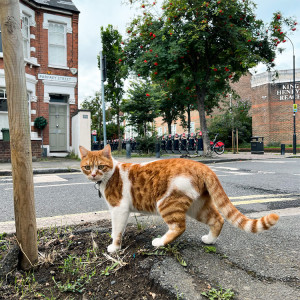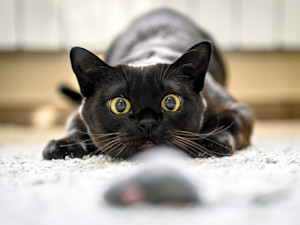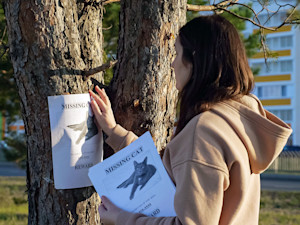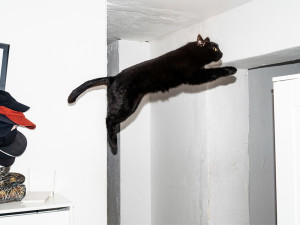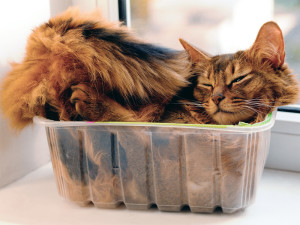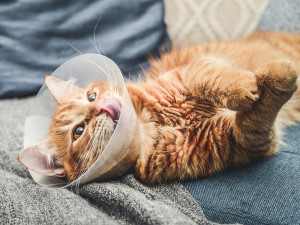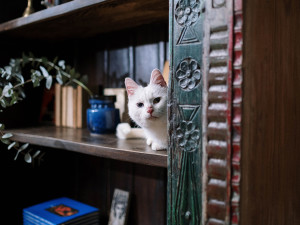How Cat Tracking Made Me A Better Pet Parent
Finally, the secrets to my cat’s outdoor life have been unlocked

share article
My sister and I have been tracking our cats for a while. She has black catopens in a new tab named Fox and mine is a calico called Ness. We also each have a tortoiseshell, though neither are especially keen on going outside.
Tracking our cats outdoors with a special GPS collar has enabled us to dip into a side of their lives that we rarely have the luxury of seeing. It turns out that both Fox and Ness spend quite a lot of time sitting in a neighbour’s garden or wandering through a nearby forest. What has been reassuring is seeing that neither of them cross any of the nearby roads – something we’d both been slightly worried about considering the estimated 23,000 cats lose their life to traffic each yearopens in a new tab.
It’s been so interesting to see their little routines. Cats are famously territorial, and Ness will only enter certain gardens during certain points of the day. Fox travels to one particular spot in the woods every day at a similar time. They certainly like to patrol an area and like to be outside consistently at the same times.
Can I track my cat with their microchip?
Tracking is different than microchipping. Microchips exist to help lost, stolen and injured pets reunite with owners. (You’ve probably heard about the new law coming into play in England this summer: from 10 June it will be a legal requirement to microchip your catopens in a new tab and you may be fined up to £500 if you don’t.) Of course, while this is useful if someone else wants to identify who a cat belongs to, a microchip does not offer any way for the cat parent themselves to know where their cat is.
This is where trackers differ because a tracker gives live updates about where your cat is. Ness keeps her collar on regularly, and if she’s been outside for a while without reappearing I simply check the app and see where she is. Usually, she is sat in some nearby bushes and has no interest in coming inside anyway!
Remember, trackers are not a replacement for a microchip, and even if you wish to get one, you will still need to ensure your cat is microchipped by June.
How far is ‘normal’ for a cat to roam in a day?
Sarah Ellis, Head of Cat Mental Wellbeing and Behaviour at International Cat Careopens in a new tab, says “Roaming for a pet cat varies depending on a number of factors including where the cats live. For example, cats living in more rural areas tend to have larger home ranges than those living in more suburban areas. A range of studies across a number of countries recorded home range sizes vary from less than a quarter of a hectare (1 hectare = 10,000 sqm) to over 5 hectares.“
How far your cat roams will also depend on whether they are neutered or spayed. Cats who have not been neutered or spayed are far more likely to roam further in search of a mate. Unneutered male catsopens in a new tab will also maintain a larger territory and are more likely to fightopens in a new tab with other cats in the local area.
What should your cat‘s routine look like?
Elle Boden, Regional Behaviour Officer for Cats Protection, says, “Cats thrive on routine and predictability, therefore you may see a regular pattern occurring when it comes to going outdoors. For instance, some may go out soon after eating. However, in colder, wet weather you may find they change their routine and spend less time outdoors.”
Sarah recommends structuring times your cat is allowed out if they don’t have free access to come and go. She says, “Making that routine predictable and consistent can make it easier for the cat, for example, they are less likely to get frustrated during the times they are restricted indoors. I would certainly recommend for any cats with outdoor access that their owners teach them to come when called so that they have a means of getting them home when they want.”
What behaviour should concern you?
Elle says that it’s a good idea to try to have a rough idea of your cat’s habits for going outdoors so you can investigate any changes in behaviour. “If they suddenly start going outdoors a lot more, there may be something causing them stress in the home such as a new petopens in a new tab, babyopens in a new tab or frequent visitors,” she says. “Likewise, if they’re suddenly reluctant to go outside, it may mean there’s an underlying medical or behavioural cause. We would always recommend seeking veterinary advice if you do notice any changes in your cat’s behaviour.”
So, why should you track your cat?
Well, first and foremost, it’s exciting to see what your cats get up to during the outside time that leaves us separate from them. If, like me, you’re an obsessive cat parent, you miss them when they’re outdoors. The tracking collars enable you to see what they do when they leave you and get to know their different routines.
But aside from just being nosey, it’s enabled me to check that my cats aren’t visiting other homes. I was slightly suspicious that my cat was being fed by a neighbour, but having tracked her for a while that doesn’t seem to be the case. Ness is never gone for more than two to three hours at a time, but some cats can roam for much longer. If you’re concerned about where they are going (for example, visiting a neighbour for food), cat trackers allow you to check that everything is fine.
Any reason why I shouldn’t track my cat?
The experience can be weirdly stressful. When the GPS shows they are near a road, it definitely brings some anxiety with it. From time to time, the GPS will drop out, too, because of buildings and trees, and that can also be anxiety-inducing if you think you should be able to see where they are and suddenly you can’t.
The GPS can also be a problem. The trackers are not always accurate 100 percent of the time and might appear to show your cat in another house or next to or on the road. This does not actually mean they are, and you run outside in a panic only to find them sitting casually watching bugs from your garden hedge (this did literally happen to me once). These trackers aren’t perfect, and you must bear this in mind if you know yourself to be the kind of person who can get easily stressed.
What should I do if my cat goes out of range?
Some of the cat trackers have no range, and my cats don’t go beyond a 100-yard radius, regardless. Other trackers have a limit, and if your cat goes beyond that then you can either wait or try to find them. These trackers will connect to a specific range and reconnect within that if you travel in the right direction.
Of course, that’s quite difficult if you’re unsure of the direction or, like me, your garden backs on to hundreds of gardens that you can’t simply wander through trying to find your cat.
If your cat has gone missing and you are at all worried about the worst-case scenario, then check out our advice for what to do if your cat goes missingopens in a new tab.
What are the best trackers to buy?
My sister and I both use a Tractive collaropens in a new tab, considered one of the high-end collars, which costs between £30–45 depending on what deals you can find. Tractive also requires a monthly subscription, however, which costs £12 a month. You can pay yearly for more benefits but this is £72 and is quite a lot of cash upfront if you‘ve already spent £40 on the collar.
The collar works well, and you get to see a map history of where they’ve been. The GPS isn’t perfect and it can take a few minutes to find your cat sometimes, but it’s fairly accurate and gives you a good idea of what they’re up to. Tractive also offers a paid upgrade with a wellness section, which allows you to keep track of the cat’s daily exercise, distance covered and see how much activity other Tractive cats in the local area are getting.
Other cat-tracking options are available. Tabcatopens in a new tab has an option that is a flat £89.99 fee but does not include monthly payments for usage, making it one of the cheaper options on the market. It has a limited range, however, and will only locate cats within 400 feet. Not much use if your cat wanders further or gets lost, as you need to get inside that range for a reading.
In the UK, Weenect opens in a new tabis another one of the more reliable brands, though user reviews state some inconsistencies with GPS and complicated usage instructions. The Weenect costs £78 but only has a £4 a month subscription to use, so works out cheaper than Tractive in the long run.
George Fallon
George is a writer whose work has featured in Business Insider, Now Then Magazine and Zone Coverage. He has two cats named Ness and Beverley. George is a Minnesota Timberwolves obsessive from Cornwall who named his tortie Bev after the infamous NBA player Patrick Beverley.
Related articles
- opens in a new tab
Can Cats Swim? What You Need to Know
More importantly: do they want to?
- opens in a new tab
How High Can Cats Jump?
Seriously, your kitty’s a little Olympian
- opens in a new tab
Are Cats Liquid?
Like, no. But also… yes? Right?
![a tattooed person with curly red hair on a couch pets a brown and black cat]() opens in a new tab
opens in a new tabCan Your Cat Smell If You’re Stressed?
And will they do anything about it if they do?
![Image of orange cat with veterinary cone on its head.]() opens in a new tab
opens in a new tabNeutering Male Cats: Behaviour and Recovery Guide
If you’re bracing yourself for some wackiness, don’t worry – it won’t last forever
![Male and female cat lying side by side.]() opens in a new tab
opens in a new tabMale vs Female Cats: What Are the Differences?
There’s more to it than you might think
- opens in a new tab
Why Is My Cat Hiding?
No, they’re not on the lam. Here are four reasons your cat might be MIA
